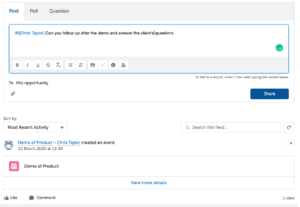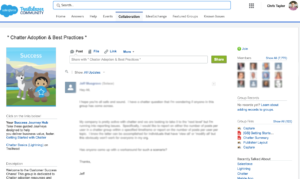When starting out with CRM Analytics, you have a blank canvas. Unlike with standard operational reports in Salesforce you do not have report types or any data to report on. This means you need to plan and prepare this data yourself in the Data Manager. Although you have to do this work yourself, it gives you great power and much can be accomplished using clicks not code. Continue reading “Preparing CRM Analytics Data With Clicks Not Code”
Author: Chris Taylor
Powerful CRM Analytics Visualisations Without Code
Many businesses have vast amounts of data. However, they struggle to find insights from this data to drive the business forward. CRM Analytics allows you to bring your CRM data together with other data sources from across your business to create powerful dashboards that can drive behaviour and uncover insights that may otherwise have been unknown, all without leaving Salesforce. Continue reading “Powerful CRM Analytics Visualisations Without Code”
Are you ready to migrate to flow?
In the summer of 2020, Salesforce announced that Flow was the future and started putting more resources behind the development of the tool. While they also stopped the future development of other tools. Then, a year later, Salesforce announced its plans to retire Workflow Rules and Process Builder starting in Winter’22 (October 2022).
What are CRM Analytics App Templates?
When you first get your hands on CRM Analytics (Tableau CRM), or when you have been provided with a new set of business reporting requirements, it can be a daunting task to decide where to start. However, as is often the case with CRM Analytics, there is help at hand in the form of App Templates.
Performing a Salesforce data export
As of August 2020, Salesforce no longer offers the data recovery solution it once provided. Although this solution was costly and not ideal, it does mean that if you do not have backup processes in place, you no longer have this last resort. As a result, it means you could suffer a data loss that you can’t recover from.
4 Signs you should be considering CRM Analytics (Einstein Analytics)
One of the most frequently asked questions I get when talking about CRM Analytics (Einstein Analytics) is, “Why should I pay for additional licences when I already have standard Salesforce reports and dashboards?”
This post is here to help you understand if you should invest in CRM Analytics by looking at four common requests that standard Salesforce reporting can’t handle.
Continue reading “4 Signs you should be considering CRM Analytics (Einstein Analytics)”
Summer’20 Einstein Analytics Release Highlights
We are not far off the Salesforce Summer’20 release (currently scheduled for mid-July). Although the core Salesforce platform features usually grab the headlines, it is another big release for Einstein Analytics.
So what features do we have coming very soon (already in sandboxes)?
Continue reading “Summer’20 Einstein Analytics Release Highlights”
Building powerful dashboards by using the right chart type
Charts in dashboards are used to help tell stories on your data. They help us to quickly identify the progress towards Key Performance Indicators (KPI’s), identify trends and patterns within your data. If you chose the wrong chart type, you risk users not being able to identify the information they need quickly, or worse, confusing them.
Continue reading “Building powerful dashboards by using the right chart type”
Improving collaboration on Salesforce
As any remote team will know, digital collaboration is essential. Not only does it help you get to know your fellow team members better, but it can also help you be more productive.
However, most businesses will have multiple tools that overlap in functionality. This can make it challenging to know what tools you should use and when. More often than not, people then tend to fall back into email as this is where they feel most comfortable. However, generally, this is not the right tool for the job and can reduce collaboration and productivity.
Salesforce has collaboration features that you may not be using, however, can really help improve collaboration when working with customer data.
Collaboration on Chatter
Chatter has been around since 2009. As an enterprise social network, Chatter is a way of helping everybody stay connected in a similar way to how you would use Facebook, LinkedIn or Twitter. It can be used by Employees (even if they don’t use Salesforce), Partners and Customers.
Chatter contains many features that would be familiar to anybody using social media. This includes posting updates, mentioning other users and sending images & attachments. Along with this, you can also post set questions, create polls and build custom actions.
Many businesses are not sure how they can get started with Chatter, and as such, it is often overlooked as a collaboration tool. To get started, you need to get an understanding of what the tool can do, who is going to use it and the purpose.
Getting Started with Chatter
Within Chatter, you can follow people and records, making a personal daily feed of activity. This allows you to get an update on what is important to you without having to build reports or look at records.
There are many features of chatter that can aid collaboration if used regularly. These include:
Record Feeds
Each record within Salesforce has its own feed (including dashboards). The feed can be populated with automatic updates such as field changes (e.g. Person A has updated field Stage from Proposal to Committed) or posting updates manually to the record.
An excellent way for teams to improve collaboration on customer accounts is to use the feed to share updates specific to the record. These updates can include mentioning users (start by typing @) who will then be notified.
Keeping all internal account communication to a single feed will help you find specific notes, reduce the number of emails sent and start conversations on topics that are visible to other users.
Chatter Groups
Groups are rooms of certain individuals that can be public or private depending on their need. Each group will have members that can publish and view posts.
Private groups are great for teams to share knowledge, information & documents. They keep discussions in a single place rather than using emails that can potentially get lost or left unread. You can even invite customers to private chatter groups, so they have space where they see updates and shared documents.
Public groups can be used for sharing company updates as well as collecting information on specific topics that are relevant to a broad audience. For example, you can create a group for each major competitor. These groups can be used to share information related to that competitor and ways you have beaten them on deals. This can then be used as a resource hub by other members of the team when they are going up against that competitor to give them the ammunition they need to help them win their deals.
The best place to see groups in action is through the Trailblazer Community.
Streams
Streams are custom feeds that you can build from the people & records you follow as well as groups that you are members of. They are a great way to focus on the feed information that is most important to you. You can get alerted about ongoing activities that you may not have been mentioned in explicitly.
How do I get started?
The best place to find out more on Chatter is through Trailhead. After that, if you are still not sure where to start, or you are looking at ways to improve collaboration on Salesforce, get in touch and one of our experts will be happy to help.
Getting Einstein to predict your future
Einstein Prediction Builder is a point and click AI tool and is available to purchase as one of the tools within the Einstein suite. In the Spring ’20 release, customer can now get one free prediction. So what is Einstein Prediction Builder, and what can you do with it?
Stepping into the world of Einstein Analytics
Einstein Analytics is a product that is evolving rapidly and becoming more popular, mainly due to licences being included with other Salesforce projects such as Pardot.
Continue reading “Stepping into the world of Einstein Analytics”
Time to Spring into Action
It’s that time of year again. We may still be in Autumn, running Salesforce Winter. However, Spring’20 is just around the corner.
